A Closer Look at Lice Bites and Rashes with Pictures
Question:
Do head lice bite? What do lice bites look like?

Answer from a Lice Expert:
Yes, lice bite! In fact, lice feed on your blood multiple times a day. This article is loaded with pictures to help you determine if what you're finding on your child is associated with lice bites.
Lice are small parasites that live, breed, and feed on humans. Many people with lice find bites and rashes on their neck, behind their ears, or even in their groin (if it's pubic lice). So many bug bites look so similar, so use the pictures below to determine if what you have is a result of lice or something else.
This article takes a meticulous look at these specific bites and rashes (feel free to click a hyperlink):
Let me introduce myself...

Hi there! I'm Theresa, I'm a lice expert, lice coach, and Registered Nurse. I help people with lice every day! You can get rid of lice in ONE DAY at home by using the same proven professional technique that I use in my lice center.
Just follow the step-by-step videos and be done with lice by the end of the day.

The 4 Types of Lice
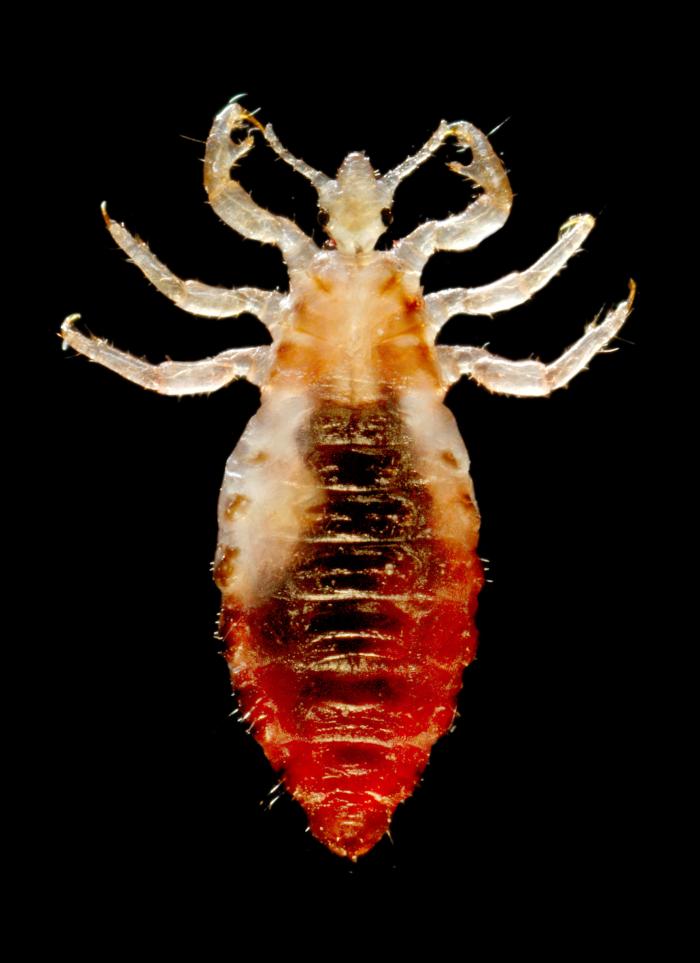
Lice are bugs that range from being microscopic at birth to about the size of a sesame seed as adults. Lice require a human host as they need to feed on human blood frequently. There are three types of lice that live on humans: head lice, body lice, and pubic lice.
A fourth type of lice making news these days is a new strain of head lice, called super lice. Super lice and regular head lice are virtually the same bugs, except super lice have mutations that make them very difficult to exterminate. These super lice are becoming the “new” strain of head lice. For the purposes of this article, we will treat the bites of regular head lice and super lice the same.
Head Lice
If your symptoms are only associated with your head, neck, and/or ears, you’ve probably got head lice.

Head lice is the most common type of lice these days by a landslide. They stick solely to the hair and near the head. They are occasionally found in facial hair, but only in severe cases. Head lice is NOT associated with poor hygiene. On the contrary, it does not matter how clean you are or how often you wash your hair; head lice are unphased by water, soap, and shampoo.

Head lice are a widespread problem in the United States, where it’s estimated that around 12 million kids get head lice every year! The largest number of kids affected are between the ages of 3-12, but head lice is also common among teens and adults.
Head lice are the only bugs that live in human hair. If you find multiple bugs in your child’s hair, the answer is yes, it is head lice.
Finding Head Lice
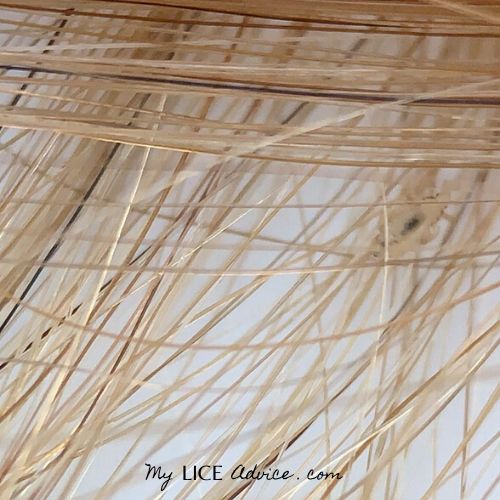
The most obvious sign of head lice is finding bugs in the hair! Head lice are the only parasites that live in human hair. However, in the early stages of head lice, finding the bugs can be very difficult because they hide quite well in hair and scatter quickly. For instance, can you spot any lice hiding in this picture?
Here it is circled…

Head Lice Sizes
Head lice range from so small that they’re nearly invisible at birth to the size of a sesame seed when fully grown. They are tan to brown in color and often slightly translucent. They can actually be darker or lighter depending on their host’s hair or skin color.
Head lice are not dangerous and do not spread diseases, but they often make the person they are infesting supremely uncomfortable, not to mention head lice is quite contagious, easily spreading from person to person.
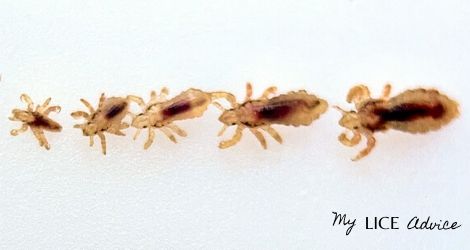
Head Lice Bites

Head lice feed on the scalp frequently, drinking human blood. Each time lice feed on your blood, a small amount of their saliva goes into your scalp. A little bit of this saliva goes unnoticed for most people, and no rash or bite marks are usually seen during this time.
After a month of this repeated feeding and injection, though, your body develops an allergic response to the lice saliva. This results in the emergence of small red bug bites or rashes on the neck, ears, and/or scalp.
Most people assume the appearance of lice bites is universal to all people, but they are not. Many people with head lice do not have any symptoms because their body does not develop an allergic reaction to lice saliva.
Lice Bites on the Neck
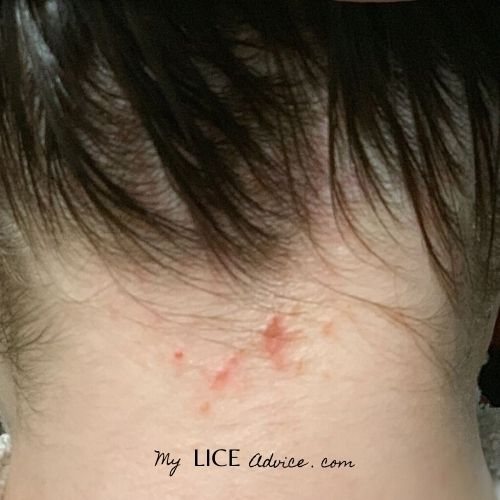
A telltale sign of head lice is small red bumps on the neck, also referred to as lice bites. For many people, this sign can show up even before itching begins.
Lice Bites Behind the Ears

The second most common place for lice bites is behind the ears and can extend to the lateral part of the neck.
Lice Bites on the Scalp

Some people develop several cyst-like bumps on their scalp, similar to acne. It is unclear whether these bumps are actually swollen areas that lice have fed (which are lice bites) or if it is an overall allergic reaction to lice saliva.
Lice Rash on the Neck and Ears

Most commonly, a blotchy, painless (or itchy) rash develops at the nape of the neck, slightly in the hair. The rash sometimes spreads to below the hairline. For a few people, this rash can extend down the entire neck.
The second most common rash is found behind the ears. A rash behind the ears is commonly bright red or blotchy red, extending to the lateral neck.
Lice Rash on the Entire Scalp

Some people end up with a red blotchy rash that covers their entire scalp.
Bites or Rash on the Shoulders or Upper Back

It is not typical for lice bites and rashes to extend past the neck. However, for those with more severe allergic reactions to lice saliva, the rash can extend to the shoulders and upper back (though head lice do not actually bite the shoulders or back, generally speaking).
If you find bites or rashes on your shoulders or back, it could be that you’re dealing with bed bugs rather than lice.
Sores and Scabs on the Scalp
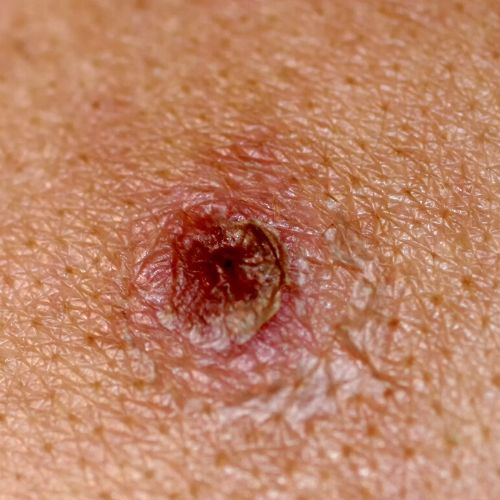
Sores and scabs on the scalp are usually the consequence of severe scratching, when fingernails dig into the scalp so intensely that the outer layer of skin is removed. In rare cases, bacteria can enter into these scabs, and a bacterial infection on the scalp may follow.
Weeping of the Scalp

In severe cases of head lice, a clear or light pink fluid (called serous fluid) can drain from the scalp. This fluid is the body’s reaction to fighting off bacteria and healing the scalp. Unfortunately, when the clear fluid dries in the hair, the hair becomes glued together and matted, usually making the head lice issue more difficult to address.
Do Head Lice Bites and Rashes Hurt or Itch?

Some rashes and lice bites are extremely itchy and uncomfortable. It feels like an itch you can’t scratch enough to satisfy. Other people may not experience any itching, only the rash or bite marks. It all depends on how your individual body reacts to head lice and lice saliva.
Other Head Lice Signs and Symptoms
The earliest sign of head lice is finding lice eggs (also known as “nits”) in the hair. These nits are often mistaken for dandruff or dirt. What is unique about nits is that they are glued onto the hair strand. To learn how to examine your child for nits, check out our tutorial, How to Check Your Child’s Head for Lice.
Other common symptoms of head lice are itchy scalp, ears, and neck. Restlessness and intense itching at night is also a tell tale sign of head lice. To learn more about the other symptoms of head lice, read our article 17 Lice Symptoms with Pictures.
Head Lice Causes

About 90% of the time, head lice is passed directly from one person to another by head-to-head contact. Hugging, snuggling, and sleeping in the same bed are prime times for head lice to move from one person to another. Head lice can also be passed from inanimate objects, especially objects that come into contact with hair, such as brushes, hair accessories, or hats.
Ways to prevent head lice include:
- Avoid direct head-to-head contact like long hugs, sleeping in the same bed, or putting your head on another’s shoulders.
- Don’t share things that come in contact with hair, like brushes, hair accessories, hats, jackets, clothing, etc.
- Make your hair undesirable to head lice by using a lice prevention spray or lice prevention shampoo every day.
How To Treat Head Lice Bites

Because lice symptoms are the result of an allergic reaction to lice saliva, the only way to get rid of lice bites and rashes is to actually get rid of lice. As long as lice are on your head, you will continue to have bites and rashes. Using an anti-itch ointment on the neck may provide limited relief, but the bites, rashes, and itching will not go away until the lice are gone.
It is common to continue to have the appearance of lice bites and rashes for a few more days, even after lice are gone. It takes time for the body to heal and recover from the allergic reaction. But all symptoms should go away within a week.
If you still have lice rashes and bites then it's likely that you still have lice. You should check out my step-by-step video system and get rid of it.
Why Is It So Hard to Get Rid of Lice?
Now that you know what you're looking for I want to talk briefly about your biggest worry (that your child actually has lice) and the question I get asked by parents around the world that have been battling lice….

Parents around the world are all asking me the same question…. "Why is it so much harder to get rid of lice now?"
Lice have become immune to everything that used to work in the past. Perhaps you remember your mom using a typical lice treatment or mayonnaise and that doing the trick. The new strain of head lice is no longer killed by those treatments, that’s why lice today are termed by people, “super lice,” because they are immune to those treatments.
I’ve cured thousands of people of lice in my lice center and let me tell you, I don't do it with over-the-counter lice treatments.

Most people struggle with lice because they focus all of their attention on killing lice bugs and not enough attention on GETTING RID OF LICE!
If you want to get rid of lice you have to address all 3 of the problems of lice:
- Lice Bugs
- Lice Eggs
- Getting Lice Back
The best way to get rid of lice is to tackle all 3 of these problems at the same time, which is what I teach in my step-by-step video system.
So, if you discover your child HAS lice, don't panic. Just head over to the video system. Follow along with the videos and you'll be done with lice by the end of the day.


How to be lice-free by the end of the day...

GET THE VIDEO SYSTEM
Get rid of lice the same way the experts do. Your personal lice coach walks you through each step of doing a professional lice treatment at home in a series of videos.

FOLLOW ALONG
Follow along with the videos on your child in your home. No lice kits or toxic chemicals involved!

BE DONE WITH LICE!
When you're done with the videos, you're done with lice. And it's gone permanently!
Summing it Up,
If you are finding bites on your neck, behind the ears or your head then you're most likely dealing with head lice. It would be VERY unlikely for you to have body lice. Below this article, there are some pictures and explanations of pubic lice and body lice if you think it likely that you have either of those.
Much more common is head lice. You can learn how to check for lice in this How to Check for Lice Tutorial. If you find lice then be sure to check out Step-by-Step Video System and get rid of it fast!
All the best,
Theresa, My Lice Advice
About the Author

Theresa is a Registered Nurse and lice expert with years of experience curing children of lice. She owns a lice treatment center in the US which is where she perfected the Step-by-Step Video System proven to get rid of lice. She also works with government agencies and schools helping those with the worst head lice cases in America.
Her greatest passion is empowering parents by teaching parents online how to do a professional lice treatment on their child at home. She is the Lice Coach for the My Lice Advice Step-by-Step Video System.
Body Lice
Body lice are EXTREMELY RARE, they are almost extinct.
If you are someone who bathes at least weekly and you do not live in a homeless camp, you DO NOT have body lice.
Body lice is the least common type of lice in developed countries. It is associated with poor hygiene and is usually only seen among those living in crowded situations with limited access to bathing facilities, such as homeless and refugee camps. If you are someone who bathes regularly, it would be extremely rare for you to have body lice.
Unlike head lice, body lice live primarily on clothing, and only come in contact with skin when feeding, so they are usually only found in the clothing, bedding, and personal items of the infested individual.
Body lice CAN transmit diseases such as epidemic typhus, trench fever, and other bacterial infections.
Body Lice Bites
Body lice bites can be found anywhere on the body, but they are most prominent in areas near the seams in clothing. This is a picture of body lice bites (though usually lice bites on the neck are head lice related).
Much more common than body lice are bed bugs and fleas. Bed bugs, like lice, are growing increasingly resistant to pesticides and are increasing in number. If you have a rash on your body, you may be dealing with bed bugs rather than body lice.
Symptoms of Body Lice
The main symptom of body lice is a constant, intense itching everywhere on your body. It’s like having hundreds of mosquito bites all over.
Just like head lice, each time body lice feed on your blood, a small amount of their saliva goes into your skin. Your body’s allergic reaction to that lice saliva causes fierce itching.
Another significant sign of body lice is that the waist, groin, and upper thighs will become darker over time, as another reaction to continuous lice bites.
Body Lice Causes
If you shower at least weekly and wash your clothes regularly, you are not at risk of getting body lice. Body lice are spread through contact with infested individuals, clothing, or other infested inanimate objects.
How to Get Rid of Body Lice
Body lice are significantly easier to treat than head lice.
- Shower or bathe regularly
- After bathing, put on clean clothing
- Wash your infested clothing and items in hot water (>130° F), and then put them in the dryer on high heat for forty minutes.
Pubic Lice (Crabs)
Pubic lice, also known as “crabs,” live in coarse hair, usually pubic hair. However, pubic lice can make their way into eyebrows, beards, and chest hair. They can also (rarely) infest eyelashes. Pubic lice is an STD and is usually only passed during intercourse.
Pubic Lice Bites
Pubic lice bites appear similar to head lice and body lice lesions, except they are generally only found in genitals and the genital area. If you have “bites” on your genitals, you likely have pubic lice.
How Do You Get Pubic Lice?
Pubic lice is almost always spread from sexual contact. If a child is found to have pubic lice, it may be an indication of sexual abuse. If you have pubic lice, you should be tested for other STDs as well.
How Do You Get Rid of Pubic Lice?
- Ideally, shave your pubic hair, if possible.
- If not, use a lice treatment to kill pubic lice.
- Remove all lice eggs from the pubic hair with a metal comb or your fingers (you don’t have to do this if you shave your pubic hair).
- Put on clean underwear and clothing after treatment.
- Keep checking with a lice comb and/or retreat 10 days later.
- Contact all sexual partners from the last month and let them know they should get checked for pubic lice.
- Get yourself checked for other STDs.
- As with head lice, clean your house items using the following principles:
48 Hours
Focus on cleaning items that have been in close contact with the body within the last 48 hours.
Wash and Dry Clothing in the Dryer
Wash on high heat (> 130° F) and dry for forty minutes on high heat all clothing and personal items that have been in close contact with the skin.
Bag Items for Two Days
Lice can’t live without blood for very long, so anything that could have lice on it will be safe to use again after 48 hours. If an item is something that you cannot run through the dryer, you can seal it away in a bag for a couple of days.



